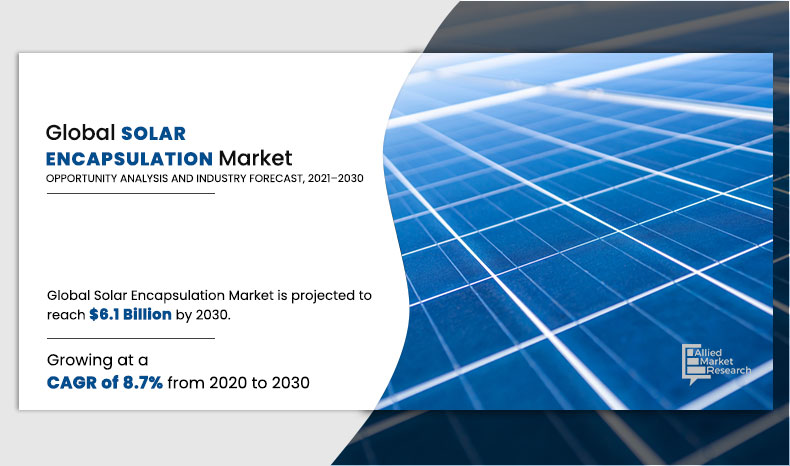Solar Encapsulation Market Overview
The global solar encapsulation market size was valued at USD 2.6 billion in 2020, and is projected to reach USD 6.1 billion by 2030, growing at a CAGR of 8.7% from 2021 to 2030. Urbanization led to increase in the demand for solar panel, which, in turn, increases the demand for encapsulation which may act as the major driving factor for the market. In addition, rise in demand for solar lights for road divider and streets create ample of opportunities for the solar encapsulation market.
Key Market Insights
- Ethylene vinyl acetate dominates the market by material in 2020.
- Polycrystalline silicon solar leads the market by technology in 2020.
- Construction is the largest application segment in 2020.
- Asia-Pacific holds the highest regional market share in 2020.
Market Size & Forecast
- 2030 Projected Market Size: USD 6.1 Billion
- 2020 Market Size: USD 2.6 billion
- Compound Annual Growth Rate (CAGR) (2021-2030): 8.7%
Introduction
The solar module back sheets contain multiple layers of barrier films and adhesives. The back sheet construction is important in protecting the solar cells from different environmental conditions such as moisture, UV exposure, and other performance threats, while improving solar module efficiency by aiding the reduction of partial module cost. The encapsulation film protects the solar cell and ensures its reliability and performance. Its role is to provide optical and electrical transmissivity by keeping the moisture out. Encapsulants provide an opportunity for realizing enhanced efficiencies in the module manufacturing process. Encapsulation is a key step in the production of solar cells. Without a good encapsulation process, even the best solar cells cannot produce good solar modules.
The encapsulation of the solar cell not only increases the life of the solar cell but also enhances the attack strength. High quality and longevity of the product is the key to winning customer satisfaction, so the encapsulation quality of solar modules is important.
Market Segmentation
The solar encapsulation market is segmented on the basis of material, technology, application, and region. Depending on material, the market is categorized into ethylene vinyl acetate, non-ethylene vinyl acetate, UV curable resin, and others. Depending on technology, it is classified into polycrystalline silicon solar, cadmium telluride, copper indium gallium selenide, and amorphous silicon. According to application, it is classified into construction, electronics, automotive, and others. Region wise, it is analyzed across North America, Europe, Asia-Pacific, and LAMEA.
By Material
Ethylene Vinyl Acetate is projected to create abundant opportunity till 2030
By Material
By material, the ethylene vinyl acetate segment dominated the global market in 2020, and is projected to remain the fastest-growing segment during the forecast period. This is attributed to its low degradability to sunlight and good radiation transmission.
By Technology
Polycrystalline Silicon Solar segment is projected as the most lucrative segment.
By Technology
Depending on technology, the polycrystalline silicon solar segment dominated the global market in 2020, and is projected to remain the fastest-growing segment during the forecast period. These solar cells are widely used and also deliver efficiencies within the range 15-25%.
By Application
Construction is projected as the most lucrative segment.
By Application
According to application, the construction segment dominated the global market in 2020, and is projected to remain the fastest-growing segment during the forecast period. This is attributed due to urbanization and expansion of cities & road network.
By Region
APAC is projected to create abundant opportunity till 2030
By Region
Region wise, Asia-Pacific dominated the global market in 2020, and is projected to remain the fastest-growing segment during the forecast period. This is attributed to numerous factors such as a large consumer base and industrialization & urbanization.
Which are the Top Solar Encapsulation companies
The following are the leading companies in the market. These players have adopted various strategies to increase their market penetration and strengthen their position in the solar encapsulation industry.
- 3M Company
- AKCOME
- STR Holding Inc.
- Bridgestone Corporation
- DNP Solar
- Dow Inc.
- Dupont De Nemours Inc
- First Solar
- Hangzhou First PV Material Co. Ltd.
- JGP Energy
Key Benefits for Stakeholders
- The report provides an in-depth analysis of the global solar encapsulation market trends along with the current and future market forecast.
- This report highlights the key drivers, opportunities, and restraints of the market along with the impact analyses during the forecast period.
- Porter’s five forces analysis helps analyze the potential of the buyers & suppliers and the competitive scenario of the global solar encapsulation market for strategy building.
- A comprehensive global solar encapsulation market analysis covers factors that drive and restrain the market growth.
- The qualitative data in this report aims on market dynamics, trends, and developments.
Solar Encapsulation Market Report Highlights
| Aspects | Details |
| By Material |
|
| By Technology |
|
| By Application |
|
| By Region |
|
Analyst Review
Solar energy can be used to generate heat for a wide variety of industrial applications, including water desalination, enhanced oil recovery, food processing, chemical production, and mineral processing. The global solar encapsulation market has registered a dynamic growth over the past few years, owing to drastic growth in above mentioned industries and urbanization. In addition, huge investment plans with respect to renewable sources of energy boost the demand for solar encapsulation across the globe. Moreover, according to the Energy Information Administration, in 2019, the industrial sector accounted for 35% of the total U.S. end-use solar energy consumption and 32% of the total U.S. energy consumption. Advancing solar technologies for industrial processes help to meet the goals of the U.S. Department of Energy Solar Energy Technologies Office to create a carbon-free energy sector by 2050. Furthermore, encapsulation film protects the solar cell and ensures its performance and reliability. Its role is to provide optical and electrical transmissivity and keep out moisture. Solar power is pollution-free and causes no greenhouse gases to be emitted after installation. In addition, it reduces dependence on foreign oil and fossil fuels and with that power could be available every day of the year, even cloudy days produce some power.
Increase in governmental tariffs coupled with solar energy and rising demand for roof top PV installations in developing economies are the major driving factors for the Global Solar Encapsulation Market. In addition, rapid expansion R & D activities in solar products and rising demand of solar lights may create ample of opportunities for the Solar Encapsulation Market.
Agreement, business expansion and product launch are the key growth strategy of Global Solar Encapsulation Market players.
The report sample for global Rooftop Solar Photovoltaic (PV) installation System Market report can be obtained on demand from the website. Also, the 24*7 chat support and direct call services are provided to procure the sample report.
Asia-Pacific will provide more business opportunities for Global Solar Encapsulation in future
3M Company, AKCOME, STR Holding Inc., Bridgestone Corporation, DNP solar, Dow Inc., Dupont De Nemours Inc, First Solar, Hangzhou First PV Material Co. Ltd. and JGP Energy are the leading market players active in the Solar Encapsulation Market.
The top ten market players are selected based on two key attributes - competitive strength and market positioning.
Construction segment holds the maximum share of the Global Solar Encapsulation Market
Solar panel manufacturers and other solar industries are the major customers of global Solar Encapsulation market.
Increasing demand for solar encapsulation material in applications such as utility, residential and rise in government tariff and cost of production owing to drive the adoption of solar encapsulation.
Technological evolution of solar encapsulation, increasing solar power demand and rise in urbanization are the current trend expected to influence the Global Solar Encapsulation Market in the next few years
Loading Table Of Content...




